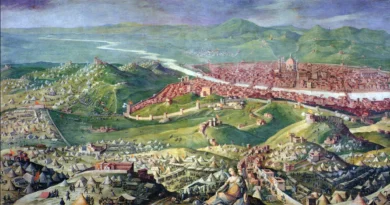Gradara Part 1: Dark Beginnings
To understand the siege of Gradara one must first go back hundreds of years.
Ever since the fall of the Empire of the Ceasars’s The Marche region has been dominated by warlord families. While technically under the control of the papacy, no pope could ever control the hundreds of warlord families in their mountaintop fortresses and waging ruthless petty wars, although many popes have tried! This tumultuous landscape has bred a culture of power, betrayal, and bloodshed, where might makes right and only the strongest survive. Amidst this chaos, two families emerged as the dominant forces: the Malatesta and the Montefeltro.
One “Family”
Once the Malatesta and the Montefeltri were one family. Long before even the Normans had crossed the sea to England or even come to Italy. The knight Rudolfo di Carpegna gained such a brutal reputation as a fighting man he gained the name “Malatesta”, evil-minded. With this ruthlessness and cunning he carved a small holding for himself and built a small fortress on the rocks above Penabilli close to Rimini. As his children and their children increased their small empire by fire and blade the name “Evil Minds” stuck and they wore it with pride.

The Split

When the Holy Roman Emperor invaded Italy to bring it and Papal power under imperial control Italy split, brother against brother as some chose to support the emperor and secular power and others supported the church. The war of the Guelphs and Ghibelines left blood on battlefields and city streets as families and cities tore themselves apart.
By this time the Malatesta had forged themselves into a brutal and formidable clan of mercenary warlords owning mountain fortresses and cities. The head of the clan was a ferocious commander known as Malatesta da Verucchio commonly as il Mastino “The Mastiff”. He saw the conflict as a ladder to be climbed, a chance to lubricate the rise of his clan with blood. The Malatesta originally favoured the emperor, but after the defeat of imperial forces, the Mastiff turned on his former master and joined the Pope. Those however of the clan who were lords of the mountain strongholds of Montefeltro and Urbino held out, not giving up on the dream of imperial rule triumphing over the church and discarding the name Malatesta and becoming the Montefeltri. With this, a bitter rivalry was born.
Gradara’s Witness to Horror
After this, the Malatesta family started its true descent into infamy. The Mastiff continued to consolidate power. He cleansed his capital of Rimini of Ghibiline supporters having all the heads of the house of Parcitati killed in one brutal night. His son the allegedly one-eyed hunchback known as the Paolo the little Maletesta or otherwise as “of the eye” for his single eye or “the warlike” brought the family to darker depths. He soon became described as the “great tyrant” or the “traitor who sees with only one eye”. His younger brother became known as a shining hope for the family, a dashing commander, accomplished diplomat and favourite of the pope he attracted the attention of his elder brother. When Paolo discovered his wife in amorous embrace with his brother at the castle of Gradara he slaughtered them. The crypts of Gradara are still said to house the sighs of their ghosts. Soon after Paolo also drowned two nobles he invited under a truce drowned in front of him. In Dante’s Inferno Paolo’s crimes earn him a place in the deepest circles of hell.
With this, the reputation of the Malatesta was firmly set and as the years went on the now separate Montafeltro clan and the Malatestas found themselves in bitter rivalry, often serving different masters across the battlefield and engaging in petty warfare and intrigues seeking to weaken or humiliate the other.

The Fight Continues
Now in the year of our lord, 1446 the rivalry of these two houses persists and those that stand at their heads are among the greatest fighting men and humanists Italy has ever known.

The Light of Italy
The pensive young Federico Montefeltro, the leader of the Montefeltro family, is a brilliant military commander and a just ruler. He is known as the “Light of Italy” for his unwavering commitment to justice and honour. His is one of the greatest libraries in Italy, his court is a haven for artists and poets, his wife is renowned for her patronage of learning. Federico’s reputation as a fair and wise leader earns him the loyalty of his people and the respect of his adversaries. His men follow him unquestioningly knowing his reputation for generous pensions for taking care of the families of those who fall or are crippled in his service.
Dark Rumours
Some things may not be as they seem, however. Rumours circulated that Federico may have schemed to depose the previous ruler of Urbino, using his cunning and political acumen to secure his own power. Some also whisper his record of invincibility may come from quietly disappearing from the side of a losing employer the moment the wind turns bad rather than sticking with his employer till the bitter end. While these allegations were never proven, they cast a shadow over Federico’s otherwise spotless reputation.
The Wolf of Rimini
The dashing commander Sigismondo Pandalfo Malatesta has gained the title of the Wolf of Rimini now leads the Malatesta clan. Despite his youth he has proven himself a brilliant commander. He rules the Malatesta clan with a firm fist reining in it’s excesses and focusing it on military victory. He has also wedded the daughter of the newly risen Condottieri clan of the Sforzas. He possesses the only library of classics that outstrips Federico da Montefeltros is Sigismondo’s own. He has gained a reputation as a brilliant strategist and headstrong fighter.
A new hope?
He however seems to be cut from different cloth than his ancestors. Some dark rumours still swell about him as they do all warlords, but they do not yet seem to stick. His justice and learning have won him the love and devotion of his people, especially those of Gradara. He is dedicated to building a new version of Italy, one modelled on classical grandeur his new church is almost heretical in its allusion to pagan Roman temples. Will Sigismondo be the one to change the dark reputation of his family?





